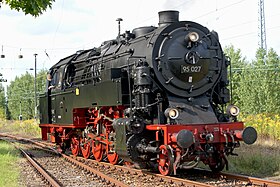DRG Class 95
| Prussian T 20 DRG Class 95 DR Class 95.0/1 |
|
|---|---|
 |
|
| Number(s) | DRG 95 001–045 |
| Quantity | 45 |
| Manufacturer | Borsig, Hanomag |
| Year(s) of manufacture | 1922–1924 |
| Retired | 1978 |
| Axle arrangement | 1′E1′ h2t |
| Type | Gt 57.19 |
| Track gauge | 1,435 mm (4 ft 8 1⁄2 in) |
| Length over buffers | 15,100 mm (49 ft 6 1⁄2 in) |
| Height | 4,550 mm (14 ft 11 1⁄8 in) |
| Overall wheelbase | 11,900 mm (39 ft 1⁄2 in) |
| Empty weight | 103.7 t (102.1 long tons; 114.3 short tons) |
| Service weight | 127.4 t (125.4 long tons; 140.4 short tons) |
| Adhesive weight | 95.3 t (93.8 long tons; 105.1 short tons) |
| Axle load | 19.1 t (18.8 long tons; 21.1 short tons) |
| Top speed | 70 km/h (43 mph) |
| Indicated Power | 1,192 kW (1,598 hp) |
| Driving wheel diameter | 1,400 mm (4 ft 7 1⁄8 in) |
| Leading wheel diameter | 850 mm (2 ft 9 1⁄2 in) |
| Trailing wheel diameter | 850 mm (2 ft 9 1⁄2 in) |
| No. of cylinders | 2 |
| Cylinder bore | 700 mm (27 9⁄16 in) |
| Piston stroke | 660 mm (26 in) |
| Boiler Overpressure | 14 bar (1,400 kPa; 200 psi) |
| Grate area | 4.36 m2 (46.9 sq ft) |
| Superheater area | 62.50 m2 (672.7 sq ft) |
| Evaporative heating area | 200.00 m2 (2,152.8 sq ft) |
| Water capacity | 12.0 m3 (420 cu ft) or 12,000 L (2,640 imp gal; 3,170 US gal) |
| Fuel | 4 t (3.9 long tons; 4.4 short tons) coal |
| Brakes | Knorr compressed-air brake Riggenbach counter-pressure brake |
The German DRG Class 95 was a ten-coupled tank locomotive with a 2-10-2 wheel arrangement, which was procured by the Deutsche Reichsbahn (also referred to later as the Deutsche Reichsbahn-Gesellschaft or DRG) in 1922 for hauling heavy goods trains on steep main lines. Because the development of this class was begun by the Prussian state railways, it was designated as the Prussian Class T 20.
The first ten locomotives, built in 1922, were ordered as T 20 Magdeburg 9201–9210 and, because they were at first intended to be grouped into Class 77, were supplied as numbers 77 001 to 77 010. By 1923 they had been renumbered to 95 001–010. A total of 45 locomotives were built by 1924. Their areas of operations included the Sonneberg–Probstzella line, the Spessart ramp, the Franconian Forest Railway, the Geislingen ramp (Geislinger Steige), the Schiefe Ebene and the Rübeland Railway, where they earned their nickname Bergkönigin ('mountain queen').
The locomotives were the most powerful tank engines procured by the DRG. They could haul a train load of 2,060 tonnes (2,030 long tons; 2,270 short tons) at a speed of 50 km/h (31 mph) on the flat and could still manage 430 tonnes (420 long tons; 470 short tons) at 25 km/h (16 mph) on a 25‰ (2.5%) incline. The very high traction load of 95.3 tonnes (93.8 long tons; 105.1 short tons) enabled it to cope with inclines of up to 70‰ (7%) without needing a rack and its Riggenbach counter-pressure brake ensured that it could brake even heavy loads on a downhill stretch.
...
Wikipedia
